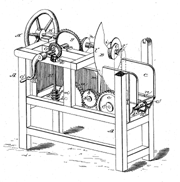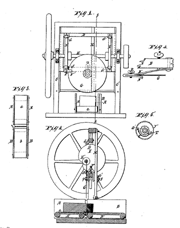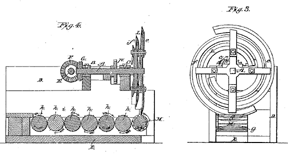When cutting in, i.e., removing the
blubber from the whale, the blubber was cut by spades, under
direction of the second mate, into a six-foot wide strip and
hoisted up to the block on the mast by huge tackle and a blubber
hook. This huge strip about 14 feet long was called a blanket
piece (see photo at the left and also the description under "Spades").
When the blanket was hoisted as high as it could go, known as "two blocks" (when the
two huge pulleys, or blocks, came together), another blubber
hook, blubber toggle or chain of a chain-strapped lower block
was attached through a hole cut in it. This hole was cut with
a boarding knife. When a strain was put on the second tackle
to support the blanket, the hoisted blanket was cut off above
the new point of attachment with the boarding knife. The process
was known as "boarding", i.e., bringing the blanket
piece on board. Thus the name of the whalecraft used was a boarding
knife. Boarding was the job of the third mate.
The boarding knife was a long, double-edged blade very similar to a sword, mounted on a short wood handle by means of a closed-seam socket forged to the end of the blade. The boarding knife was usually secured by means of a screw or pin through the socket and wood handle. A Turk's head knot was often tied at the base of the blade where it joined the socket. This was to prevent a bare hand from sliding along the oil soaked handle onto the razor sharp blade during use. After steel became widely available in the mid 1800's the blades of boarding knives were made of steel because it would hold a sharp cutting edge far better than wrought iron. When not in use, the boarding knife was kept in a wood case made on board by the whalemen.
Sometimes boarding knives were made
from discarded swords or Navy cutlasses, adapted for use as boarding
knives, as an economic move.
After the blanket piece was cut into
horse pieces (about six feet
long - the width of the blanket - and one foot wide), the horse
pieces were taken to the mincing horse. This consisted of 2"
planks about 1 ft. wide and 3 ft. long across a tub to hold the
minced blubber. Several wood pegs along the side of the planks
kept the horse piece in place while mincing. To facilitate trying
out, or boiling the blubber down to extract the oil, the surface
area of the blubber was increased by slicing it into thin slices,
about 1" thick. The thin slices were left attached to the
blackskin like the pages of a book attached to the spine. This
was then called "books" or "bible leaves."
Slicing the horse pieces into bible leaves was called mincing,
and was done with a mincing knife.
Photograph by Albert C. Church
A mincing knife was a long blade about 24" long and 4" wide, only about 1/16" thick, with a wood handle on each end. The top of the thin blade was reinforced with a metal rib across the entire length. The lower edge was sharpened to slice the blubber. Blubber is not easy to cut, and mincing was done with a sideways slicing motion, not a straight plunge downward. A horse piece was placed on the plank and while one man pulled it along the plank with a small hand hook another man sliced it into bible leaves with the mincing knife. When not in use, the mincing knife was kept in a wood case made on board by the whalemen.
It should be noted that in the Dutch,
English and Scotch northern whale fisheries blubber was not boiled
down into oil on board ship. It was cut into small pieces and
stored in casks to be taken back to shore for extracting the
oil. The process of cutting the blubber into small pieces and
stowing it in barrels was known as "making off" and
was done liesurely when the crew was not pursuing whales. The
exception was sperm oil, which had to be extracted as soon as
possible by boiling the blubber, otherwise it would become a
dark, thick mass.
There was no change to the design of the mincing knife, however some mincing machines were developed to replace hand mincing. These required only one man to load horse pieces into the machine and then turn a hand crank. The bible leaves were more more uniform, also. There was an early U.S. Patent granted to B. Taber of Fairhaven, Massachusettes on August 11, 1821 for a "whale blubber mincing machine." Practically all early patent records were destroyed in a fire in 1836 at the Patent Office, so details of this invention are not known. Another early U.S. patent was granted to W. Ball of New York City on April 25, 1822 for a "knife for cutting up blubber," but those records were also lost in the fire in 1836.
There
were at least four other patented mincing machines, but one was
used more than any other, and serves to illustrate these whaling
tools. This mincing machine is illustrated above, and was patented
by George W. Sowle and
William Carsley of New Bedford, Massachusettes on Oct. 6, 1843
(U.S. Patent No. 3,290). The mechanism of their hand-cranked
machine automatically fed the horse piece forward the proper
distance on a conveyor belt at the bottom of a wooden trough.
It was then sliced nearly through by a drawing stroke of a mincing
blade. The mincing blade returned to its initial position and
the horse piece moved forward for the next slice. This alternating
action was accomplished by turning the hand crank which was geared
to a large flywheel to maintain smooth action. The conveyor belt
and mincing blade were linked to the crankshaft by means of gears
and a cam.
Patent drawings for Sowle and Carsley mincing machine.
The conveyor belt was made of leather with strips of wood secured across its width. Nail points projected up from the wood strips to grip the blubber as it moved through the machine. Any reverse motion was prevented by a ratchet.
The mincing blade was bolted to a frame fixed directly to a jointed crank mechanism. The claim in the patent was for the method of fixing the knife blade directly to the crank. This can be seen in the photo above.
Other patents for mincing machines were similar and are not discussed in detail. The patent drawings and a brief summary description will suffice. If more detail about a particular mincing machine is desired, please send me email with your request.
G.
and J. J. Kilburn of Fall River,
Massachusettes received a U.S. Patent on Nov. 16, 1841 (U.S.
Patent No. 2,368). They called their invention the "Fly-Mincer."
The patent claims specified:
We do not claim the knife on the wheel or the opening in the face of the wheel, nor the beveled edge of the wheel, as these have long since been known and used separately, as also the hopper; but ... What we do claim as our invention, and desire to secure by Letters Patent, is -----Making the back face of the wheel beveled toward the periphery, and the beveled opening through which the blubber passes after it has been cut, in combination with the curved knife, and these thus combined in combination with the arrangement of the hopper, so that the part cut shall not be entirely severed from the mass in the hopper, all substantially as herein specified.
 It will be observed that the knife ... makes
a complete revolution at each cut, and the whole length of the
knife-edge passes through the blubber laterally, while the vertical
cut, on account of the spiral shape of the knife, is only about
one-eighth of said length of the knife-edge.
It will be observed that the knife ... makes
a complete revolution at each cut, and the whole length of the
knife-edge passes through the blubber laterally, while the vertical
cut, on account of the spiral shape of the knife, is only about
one-eighth of said length of the knife-edge. My machine gives a very rapid drawing cut,
and the machines heretofore used for this purpose are unable
to obtain these conditions to an equal extent. My machine, worked
in the manner first described, allows the knife to revolve at
pleasure and clear itself of fat without compelling any positive
rotary motion on the ascent. It allows the cutter to be placed
to work at any depth required, as the disk wears away, without
any adjustment of other portions of the machine. It allows the
slices to be moved to one side by the rotation of the disk without
affecting their arrangement in close contact with each other.
It compels the disk to rotate with a uniform velocity during
its descent, which may, by properly proportioning the parts,
be made that which is found most desirable in practice; and it
keeps the cutting-edge always keenly sharpened and very true.
My machine gives a very rapid drawing cut,
and the machines heretofore used for this purpose are unable
to obtain these conditions to an equal extent. My machine, worked
in the manner first described, allows the knife to revolve at
pleasure and clear itself of fat without compelling any positive
rotary motion on the ascent. It allows the cutter to be placed
to work at any depth required, as the disk wears away, without
any adjustment of other portions of the machine. It allows the
slices to be moved to one side by the rotation of the disk without
affecting their arrangement in close contact with each other.
It compels the disk to rotate with a uniform velocity during
its descent, which may, by properly proportioning the parts,
be made that which is found most desirable in practice; and it
keeps the cutting-edge always keenly sharpened and very true. nine to eleven inches in thickness, and is
very tough and firm in its consistence. These long strips are
termed by whalers "blanket-pieces," and they are usually
cut up or rendered into what are termed "horse-pieces,"
which are themselves reduced or sliced so as to become what are
termed "books," which, when formed, are pitched into
a large tub, where they are [then] boiled for the purpose of
removing the oil.
nine to eleven inches in thickness, and is
very tough and firm in its consistence. These long strips are
termed by whalers "blanket-pieces," and they are usually
cut up or rendered into what are termed "horse-pieces,"
which are themselves reduced or sliced so as to become what are
termed "books," which, when formed, are pitched into
a large tub, where they are [then] boiled for the purpose of
removing the oil.